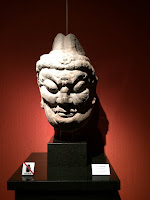Shanghai Museum
Shanghai museum is full of wonderful things, from ceramics to bronze, jade, coins, paintings, and calligraphy. There is everything you need to know about ancient China.
 |
| Milky white marble statue |
 |
| Fu Yi Gong (Wine Vessel) Late Shang (13th-11th century B.C.) |
 |
| Zun (Wine Vessel) with ox head and animal mask Late Shang (13th-11th century B.C.) |
 |
| Mu Gui Yan (Steamer) Wester Zhou (11th century B.C.) |
 |
| knife with raised bosses pattern Western Zhou 11th century B.C. |
 |
| Ge (Dagger-axe) with animal mask late Shang 13th-11th century B.C. |
 |
| Drum stand with openwork coiled dragon design Spring and Autumn (6century-476 B.C.) |
 |
| picture of drum stand (left) with a drum |
Chinese people use the method: clay molds, stack-casting, and metal molds to make bronzes starting Shang and Zhou periods (13th century B.C.). Most Shang and Zhou bronzes were cast in clay molds. I cannot believe that people can made beautiful bronzes that early. It takes six steps to turn the core into a beautiful object.
 |
| 1. making a clay model, baking the clay model and copying the outer piece |
 |
| 2. engraving the patterns on the outer molds |
 |
| 3. making two clay cores (inner colds) after assembling the outer molds covered a layer of clay |
 |
| 4. making a clay mold from a model with inscriptions and inlaying it into the clay core |
 |
| 5. assembling the molds and pasting some clay mixed with straw or chaff |
 |
| 6. baking the molds before casting, cleaning up and polishing after casting |
 |
| Model of Daigoji Pagoda |
There is a five story model of a Daigoji Pagoda. You might want to ask what is that thing above that roof. It is a lightening rod but I think the design make it look better. There are a few more Buddha. Most of them only had heads left. I think the head was stolen by tomb raiders. And some one eventually donated them to the museum.
 |
| Head of Lokapala stone 618-907 A.D. |
 |
| Buddha stele stone Northern Qi, 550-577 A.D. |
 |
| Green Glazed Pottery Watching Tower Eastern Han, A.D. 25-220 |
 |
| Painted pottery pot with swirls pattern Banshan Type of Majiayao Culture 2600-2300 B.C. |
 |
| Celadon jar with modeled human figurines Wuzhou ware Wu state of Three Kingdoms 222-280 A.D. |
 |
| Double-ring Shaped Bi (disc) with Grain Pattern Warring States (475-221 B.C.) |
There is a whole section of jade exhibition. The double-ring shaped Bi, a jade disc, is the most famous one. It was made in Warring States (475-221 B.C.). It is a flat round piece in shape of a disc with a hole in the center. It was originally used as a ritual vessel to offer sacrifice to the God of heaven, but gradually lost its ritual function in thousands of years' development. Don't forget to take a look at the jade dragon. It is a cute little one. Dragon is an imaginative animal believed as the God of Water in Chinese tradition. Starting from the Hongshan culture (30th century B.C.), shape of dragon became representing power and good luck. A jade wine cup and a jade blade of an ax were also very charming.
 |
| Jade dragon Warring States 475-221 B.C. |
 |
| Jade wine cup
Qianlong reign (1736 to 1795 A.D) Qing
|
 |
| The blade of a jade axe (3200 to 2200 B.C.) |
Shanghai Museum will definitely give you full of knowledge, from ancient treasures to modern precious things. This is a good place for fact lovers.
 |
| Thatched Cottage and Apricot by Tang Yin Hanging scroll Ming dynasty |
 |
| Flowers and Birds by Shen Quan Hanging scroll Qing Dynasty |
 |
| Reply to Xie Minshi by Su Shi Handscroll Northern Song |

No comments:
Post a Comment